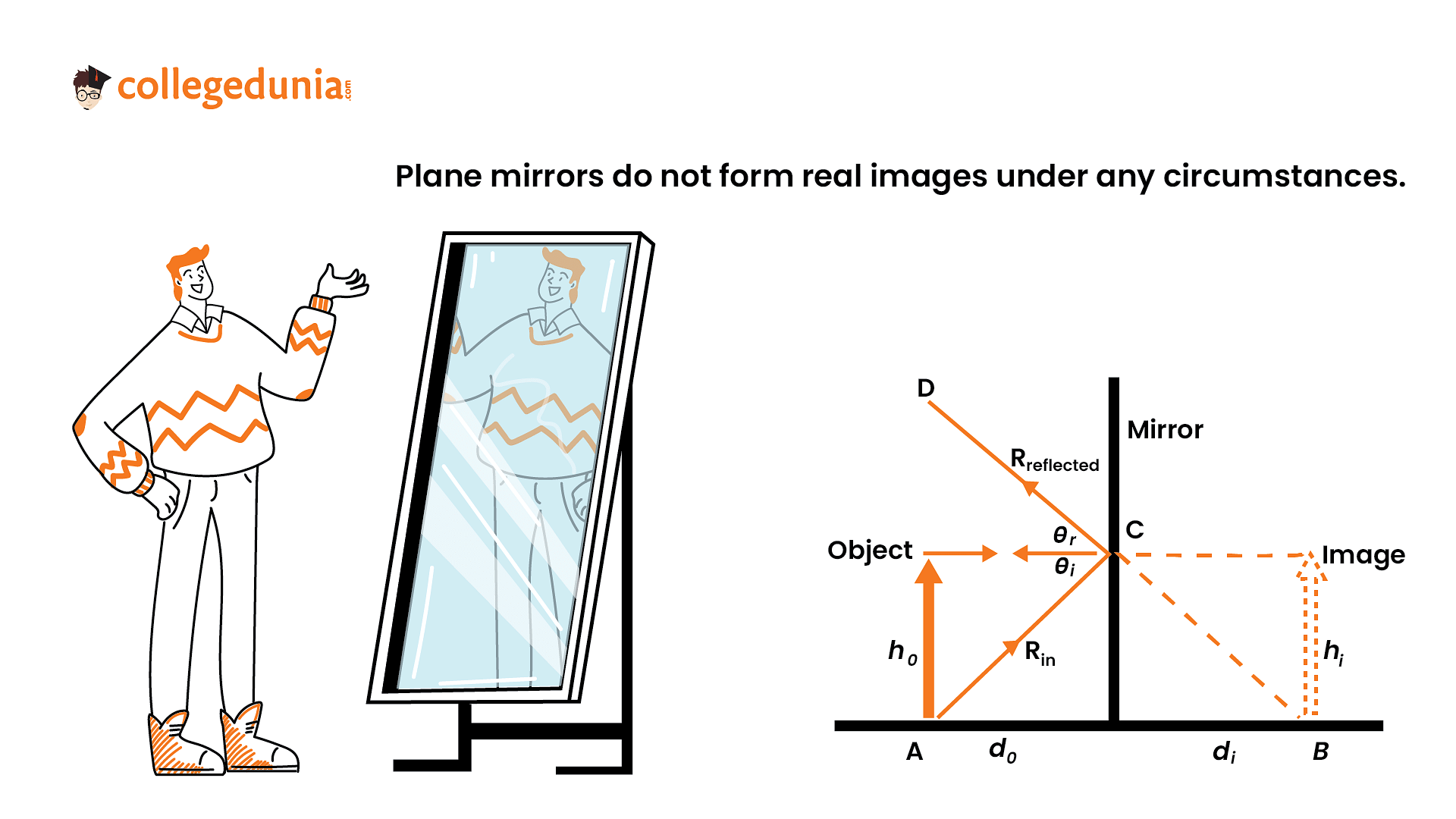The light reflected by a plane mirror may form a real image
- if the rays incident on the mirror are diverging
- if the rays incident on the mirror are converging
- if the object is placed very close to the mirror
- under no circumstances.
The Correct Option is D
Approach Solution - 1
A plane mirror cannot form a real image. The image formed by a plane mirror is laterally inverted. Only a concave mirror can form a real image.

Read more from the chapter: Light- Reflection and Refraction
Approach Solution -2
The Correct Answer is (D)
Real Life Applications
Plane mirrors do not form real images under any circumstances.
Question can also be asked as
- Can a plane mirror form a real image?
- In which conditions do plane mirror form real images?
- What are the applications of a plane mirror forming a real image?
Approach Solution -3
The Correct Answer is (D)
Plane mirrors have a flat reflective surface with no inwards or outwards curve. It reflects the light and forms virtual images. The angle of reflection of the light and the angle of incident are equal. The images formed are always upright and of the same size as the object.
Image formation by a plane mirror
The three phenomena that a ray of light undergoes are as follows:
- Reflection
- Refraction
- Absorption
Properties of the image formed by a plane mirror
- The image is always virtual.
- The magnification of the image is the same as that of the object.
- The size of the image and the object is the same.
- The images are always erect and straight.
- The image is laterally inverted.
Types of Reflection in Plane Mirror
- Regular Specular reflection
- irregular /diffused reflection
Uses of the plane mirror
- In torch lights
- Used by dentists
- Used in the solar cooker
- They are used for security purposes
- They are used in periscopes.
Read more:
Top Questions on Ray optics and optical instruments
- A concave mirror produces an image that is real, inverted, and diminished. What is the position of the object in relation to the mirror?
- BITSAT - 2025
- Physics
- Ray optics and optical instruments
- Explain the transmission of optical signal through an optical fiber with a diagram.
- CBSE CLASS XII - 2025
- Physics
- Ray optics and optical instruments
- A radio wave travels in a medium with refractive index 1.5. What is the speed of light in this medium if the speed of light in vacuum is \(3 \times 10^8 \, \text{m/s}\)?
- BITSAT - 2025
- Physics
- Ray optics and optical instruments
- A convex lens has focal length 20 cm. An object is placed at a distance of 40 cm from the lens. What is the position of the image formed?
- BITSAT - 2025
- Physics
- Ray optics and optical instruments
- Find the focal length of a lens in a compound lens system.
- BITSAT - 2025
- Physics
- Ray optics and optical instruments
Questions Asked in KCET exam
- If the number of terms in the binomial expansion of \((2x + 3)^n\) is 22, then the value of \(n\) is:
- KCET - 2025
- Binomial theorem
- Ethyl alcohol is heated with concentrated sulphuric acid at 413 K (140°C). The major product formed is
- KCET - 2025
- Organic Chemistry
- A body of mass 0.25 kg travels along a straight line from \( x = 0 \) to \( x = 2 \, \text{m} \) with a speed \( v = k x^2 \) where \( k = 2 \, \text{m}^{-1} \). The work done by the net force during this displacement is
- KCET - 2025
- Elastic and inelastic collisions
- A square loop of side 2 m lies in the Y-Z plane in a region having a magnetic field \(\mathbf{B} = (5 \hat{i} - 3 \hat{j} - 4 \hat{k}) \, \text{T}\). The magnitude of magnetic flux through the square loop is
- KCET - 2025
- Magnetic Field
- A random experiment has five outcomes \(w_1, w_2, w_3, w_4, w_5\). The probabilities of the occurrence of the outcomes \(w_1, w_2, w_4, w_5\) are respectively \( \frac{1}{6}, a, b, \frac{1}{12} \) such that \(12a + 12b - 1 = 0\). Then the probabilities of occurrence of the outcome \(w_3\) is:
- KCET - 2025
- Probability
Concepts Used:
Ray Optics and Optical Instruments
Optics, deals with the determination of behaviour and the properties of light, along with its interactions with the matter and also with the instruments that are used to detect it.
Ray optics is also known as the geometrical optics and it is a branch of science which describes light propagation.
Reflection is the change in direction of light at an interface in-between two different media so that the wave-front returns into a medium from which it was originated.
Speed of light is the rate at which the light travels in free space.
A phenomenal change in image formed when the light is passed from one medium to another which is called Refraction.
Total Internal Reflection is the reflection of light when the light ray enters into a rarer medium from a denser medium and the angle of incidence is higher than the critical angle of incidence then that light ray will be reflected back to the denser medium.
Read More: Ray Optics and Optical Instruments